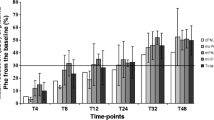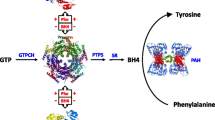Summary
Background: As part of the German Collaborative Study of Children Treated for Phenylketonuria (PKU), a three-day protein loading test was applied to children at 6 months of age. This load elicits three principal types of blood phenylalanine (Phe) response, with types I and III clinically corresponding to classic PKU and mild hyperphenylalaninaemia not requiring diet (MHP), respectively. An intermediate type II, clinically corresponding to mild PKU, is characterized by early decline of blood Phe from above 1200 μmol/L down to levels between 600 and 1200 μmol/L at 72 h. Aims: Unbiased classification and kinetic and molecular characterization of the intermediate Phe response; estimation of phenotypic variability of Phe disposal.Method: A kinetic model with zero-order protein synthesis and first-order rate of metabolic disposal of Phe is applied to 157 tests. Results: A model of exponentially saturated activation describes the acceleration of Phe disposal from day 1 to 3 in the intermediate type of response. Eleven of 14 p.Y414C functional hemizygotes and two of three p.R261Q homozygotes manifested this kinetic type. The rate estimates of Phe metabolic disposal differ widely in patients with identical PAH genotype, yet are highly correlated with the Phe level at 72 h.



Similar content being viewed by others
Abbreviations
- AV:
-
assigned phenotypic value according to Guldberg et al (1998)
- HPA:
-
hyperphenylalaninaemia
- K out :
-
first-order kinetic constant of metabolic loss/disposal
- MHP:
-
mild hyperphenylalaninaemia
- PAH:
-
phenylalanine hydroxylase
- Phe:
-
phenylalanine
- Phe72:
-
blood level of phenylalanine 72 h after start of loading (morning of day 4)
- PKU:
-
phenylketonuria
- PRA:
-
predicted residual activity (mean of in vitro activities, per cent of normal)
- t 1/2 :
-
phenylalanine half-life (50% elimination time)
References
Berman JL, Cunningham GC, Day RW, Ford R, Hsia DY (1969): Causes for high phenylalanine with normal tyrosine in newborn screening programs. Am J Dis Child 117: 54–65.
Blaskovics ME (1976): Diagnostic considerations in phenylalaninemic subjects before and after dietary therapy. J Irish Med 69: 410–414.
Blaskovics ME, Schaeffler GE, Hack S (1974): Phenylalaninemia. Differential diagnosis. Arch Dis Child 49: 835–843. doi:10.1136/adc.49.11.835
Blau N (2005): BIOPKU: International database of patients and mutations causing BH4-responsive HPA/PKU. http://www.bh4.org/BH4DatabasesBioPKU.asp
Bortz J, Lienert GA (1998) Kurzgefasste Statistik für die klinische Forschung. Springer-Verlag, Berlin.
Burgard P, Rupp A, Konecki DS, et al (1996): Phenylalanine hydroxylase genotypes, predicted residual enzyme activity and phenotypic parameters of diagnosis and treatment of phenylketonuria. Eur J Pediatr 155([Suppl 1]):S11–S15. doi:10.1007/PL00014222
Fomon SJ, Haschke F, Ziegler EE, Nelson SE (1982) Body composition of reference children from birth to age 10 years. Am J Clin Nutr 35: 1169–1175.
Fukami MH, Haavik J, Flatmark T (1990): Phenylalanine as substrate for tyrosine hydroxylase in bovine adrenal chromaffin cells. Biochem J 268: 525–528.
Gjetting T, Petersen M, Guldberg P, Güttler F (2001): Missense mutations in the N-terminal domain of human phenylalanine hydroxylase interfere with binding of regulatory phenylalanine. Am J Hum Genet 68: 1353–1360. doi:10.1086/320604
Gramer G, Burgard P, Garbrade SF, Lindner M (2007): Effects and clinical significance of tetrahydrobiopterin supplementation in phenylalanine hydroxylase-deficient hyperphenylalaninaemia. J Inherit Metab Dis 30: 556–562. doi:10.1007/s10545-007-0651-6
Guldberg P, Rey F, Zschocke J et al (1998): A European multicenter study of phenylalanine hydroxylase deficiency: Classification of 105 mutations and a general system for genotype-based prediction of metabolic phenotype. Am J Hum Genet 63: 71–79. doi:10.1086/301920
Keen RE, Spain JD (1992): Computer Simulation in Biology. A BASIC Introduction. Wiley-Liss, New York.
Kindt E, Motzfeldt K, Halvorsen S, et al (1984) Is phenylalanine requirement in infants and children related to protein intake? Br J Nutr 51: 435–442. doi:10.1079/BJN19840049
Langenbeck U (2008): Classifying tetrahydrobiopterin responsiveness in the hyperphenylalaninaemias. J Inherit Metab Dis 31: 67–72. doi:10.1007/s10545-007-0572-4
Langenbeck U, Zschocke J, Wendel U, Hönig V (2001): Modelling the phenylalanine blood level response during treatment of phenylketonuria. J Inherit Metab Dis 24: 805–814. doi:10.1023/A:1013946006155
Lutz P, Schmidt H, Frey G, Bickel H (1982): Standardized loading test with protein for the differentiation of phenylketonuria from hyperphenylalaninaemia. J Inherit Metab Dis 5: 29–35. doi:10.1007/BF01799751
Lutz P, Schmidt H, Batzler U (1990): Study design and description of patients. Eur J Pediatr 149(Supplement 1): S5–S12. doi:10.1007/BF02126292
Mönch E, Kneer J, Jakobs C, et al (1990): Examination of urine metabolites in the newborn period and during protein loading tests at 6 months of age. Eur J Pediatr 149(Supplement 1): S17–S24. doi:10.1007/BF02126294
O’Flynn ME, Holtzman NA, Blaskovics M, et al (1980): The diagnosis of phenylketonuria. A report from the collaborative study of children treated for phenylketonuria. Am J Dis Child 134: 769–774.
Okano Y, Eisensmith RC, Güttler F, et al (1991): Molecular basis of phenotypic heterogeneity in phenylketonuria. N Engl J Med 324: 1232–1238.
Pey AL, Martinez A (2005): The activity of wild-type and mutant phenylalanine hydroxylase and its regulation by phenylalanine and tetrahydrobiopterin at physiological and pathological concentrations: An isothermal titration calorimetry study. Mol Genet Metab 86(Supplement 1): S43–S53. doi:10.1016/j.ymgme.2005.04.008
Sachs L (2004) Angewandte Statistik, 11th edn. Springer-Verlag, Berlin
Schmidt H, Lutz P, Batzler U (1989): Differentialdiagnose des erhöhten Phenylalanin-Blutspiegels im Säuglingsalter. Ergebnisse der deutschen Verbundstudie über Phenylketonurie (PKU) / Hyperphenylalaninämie (HPA). Monatsschr Kinderheilkd 137: 86–92.
Scriver CR, Clow CL (1980): Phenylketonuria: epitome of human biochemical genetics. N Engl J Med 303: 1336–1342, 1394–1400.
Scriver CR, Waters PJ (1999): Monogenic traits are not simple: lessons from phenylketonuria. Trends Genet 15: 267–272. doi:10.1016/S0168-9525(99)01761-8
Thompson GN, Walter JH, Leonard JV, Halliday D (1990) In vivo enzyme activity in inborn errors of metabolism. Metabolism 39: 799–807. doi:10.1016/0026-0495(90)90122-S
Thórólfsson M, Ibarra-Molero B, Fojan P, et al (2002): L-phenylalanine binding and domain organization in human phenylalanine hydroxylase: a differential scanning calorimetry study. Biochemistry 41: 7573–7585. doi:10.1021/bi0160720
Treacy E, Pitt JJ, Seller K, et al (1996): In vivo disposal of phenylalanine in phenylketonuria: a study of two siblings. J Inher Metab Dis 19: 595–602. doi:10.1007/BF01799832
van Spronsen FJ, van Rijn M, Dorgelo B, et al (2009) Phenylalanine tolerance can reliably be assessed at the age of 2 years in patients with PKU. J Inherit Metab Dis 32: 27–31. doi:10.1007/s10545-008-0937-3
Waxman DJ, Azaroff L (1992): Phenobarbital induction of cytochrome P-450 gene expression. Biochem J 281: 577–592.
Zschocke J, Hoffmann GF (1999): Phenylketonuria mutations in Germany. Hum Genet 104: 390–398. doi:10.1007/s004390050973
Zurflüh MR, Zschocke J, Lindner M (2008) Molecular genetics of tetrahydrobiopterin-responsive phenylalanine hydroxylase deficiency. Hum Mutat 29: 167–175. doi:10.1002/humu.20637
Acknowledgement
The German 1978 to 1995 Collaborative Study of Children Treated for Phenylketonuria (headed until 1989 by the late Professor Horst Bickel, thereafter by Professor Hans Joachim Bremer) received financial support from Stiftung Volkswagenwerk and Bundesministerium für Forschung und Technologie (BMBF). Eight paediatric centres participated in the study: Berlin (E. Mönch), Düsseldorf (Hildegard Przyrembel, U. Wendel), Göttingen (A.W. Behbehani, W. Voss), Hamburg (P. Koepp, P. Clemens), Heidelberg (Hildgund Schmidt, P. Lutz, K. Bartholomé, F.K. Trefz), München (J. Schaub, W. Endres), Münster (H. Gröbe, K. Ullrich), and Ulm (Dorothea Leupold). Additional acknowledgements appeared 1990 in Eur J Pediatr 149(Supplement 1): S3–S4.
Thanks are due to Sylvia Koerner for excellent administrative work and data handling, and to Elfriede Quak, Rainer Bielen and Verena Wahl for expert technical assistance with genotype analysis.
Author information
Authors and Affiliations
Consortia
Corresponding author
Additional information
Communicating editor: Michael Gibson
Competing interests: None declared
References to electronic databases: Phenylketonuria: OMIM +261600. Phenylalanine hydroxylase: EC 1.14.16.1.
Rights and permissions
About this article
Cite this article
Langenbeck, U., Burgard, P., Wendel, U. et al. Metabolic phenotypes of phenylketonuria. Kinetic and molecular evaluation of the Blaskovics protein loading test. J Inherit Metab Dis 32, 506–513 (2009). https://doi.org/10.1007/s10545-009-1152-6
Received:
Revised:
Accepted:
Published:
Issue Date:
DOI: https://doi.org/10.1007/s10545-009-1152-6




